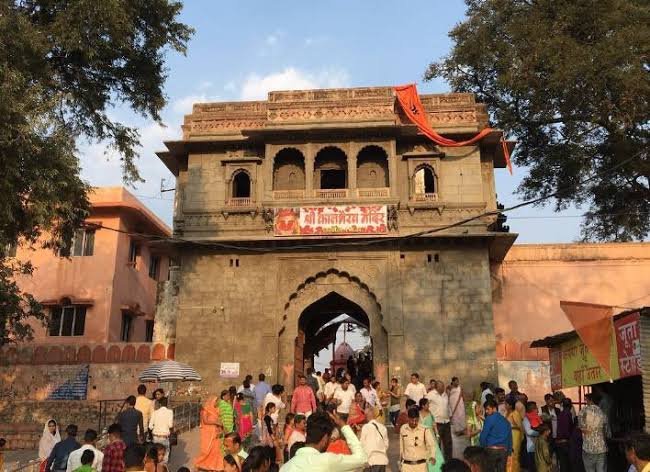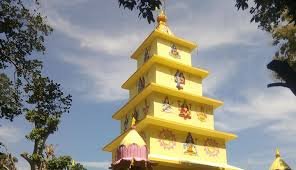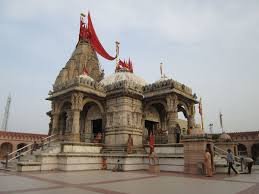Introduction
Nestled in the sacred city of Ujjain, the Kaal Bhairav Temple is not only one of the most revered but also one of the most mysterious shrines in India. Dedicated to Lord Kaal Bhairav, a fierce manifestation of Lord Shiva, this temple is deeply rooted in spiritual energy, ancient legends, and unique rituals. Moreover, its distinct traditions and powerful aura draw thousands of devotees, making it a significant pilgrimage site. As you step into this divine abode, you can immediately feel the sacred vibrations that set it apart from other temples.
Unlike other Shiva temples, the Kaal Bhairav Temple follows an extraordinary tradition—offering liquor to the deity as prasad. This unique practice, combined with the temple’s rich history and divine aura, makes it a fascinating pilgrimage site for devotees and seekers alike.
Let’s explore the legend, history, rituals, and spiritual significance of this extraordinary temple.
The Legend of Kaal Bhairav
According to Hindu mythology, Kaal Bhairav is the guardian of time and the ruler of death. He is believed to be an incarnation of Lord Shiva.
One of the most famous legends states that:
- The Trimurti—Brahma, Vishnu, and Shiva—once had a debate over who was the supreme deity.
- Lord Brahma, in his arrogance, insulted Lord Shiva.
- In anger, Lord Shiva manifested as Kaal Bhairav and severed one of Brahma’s five heads.
- This act led to Brahma Hatya Dosha (the sin of killing a Brahmin), and Kaal Bhairav roamed the world with Brahma’s skull stuck to his hand, symbolizing his penance.
- Finally, when he reached Ujjain, the skull fell off, signifying the end of his atonement.
Historical Significance of Kaal Bhairav Temple
The Kaal Bhairav Temple in Ujjain is believed to be thousands of years old. Its origins are often linked to the Gupta period (4th–5th century AD), though some believe it dates back even earlier to the Mahabharata era.
- The temple flourished during the reign of the Paramara kings, who were ardent devotees of Lord Shiva.
- Many rulers, including King Bhadrasen, contributed to the temple’s expansion.
- The Marathas later played a crucial role in restoring and maintaining the temple, preserving its ancient traditions.
This long history makes the Kaal Bhairav Temple a testament to the enduring power of faith in Indian culture.
Architectural Marvel of Kaal Bhairav Temple
The Kaal Bhairav Temple stands as a magnificent blend of spirituality and craftsmanship. Not only does it hold immense religious significance, but it also showcases remarkable artistry. Its architectural beauty is a true reflection of ancient Hindu temple design, featuring intricate carvings, vibrant murals, and an imposing deity statue. Moreover, as you walk through the temple premises, you will notice the fine detailing that adds to its grandeur. Every element, from the beautifully sculpted pillars to the mesmerizing frescoes, tells a story of devotion and faith.
1. Majestic Entrance
As you enter the temple, you are greeted by a grand archway, leading to the inner sanctum. The walls depict stories of Kaal Bhairav, creating a sense of divine reverence.
2. The Sanctum Sanctorum
- The idol of Kaal Bhairav is awe-inspiring, with wide eyes, a garland of skulls, and an intense expression.
- Unlike most temples, there is no traditional shikhara (tower) above the sanctum, giving it a distinctive look.
3. The Unique Offering Ritual
One of the most fascinating aspects of the Kaal Bhairav Temple is the unique ritual of offering liquor to the deity. Interestingly, devotees bring bottles of alcohol, which priests carefully pour into a bowl near the idol’s mouth. Surprisingly, the liquor mysteriously disappears, leading devotees to believe that Lord Kaal Bhairav himself consumes it. Furthermore, this ritual is considered a sacred act of devotion, symbolizing surrender and faith in the divine. As a result, thousands of pilgrims participate in this offering, seeking blessings, protection, and relief from worldly troubles. Not only does this tradition make the temple stand out, but it also reinforces the belief that Lord Kaal Bhairav actively interacts with his devotees.
Spiritual Significance of Kaal Bhairav Temple
The Kaal Bhairav Temple is not just a place of worship—it is a powerful energy center that resonates with deep spiritual significance. Moreover, devotees strongly believe that worshipping Lord Kaal Bhairav brings protection, prosperity, and liberation from fear. In addition to this, many pilgrims visit the temple seeking divine intervention in overcoming obstacles and attaining success in their lives. As a result, the temple remains a beacon of faith, attracting visitors from all over the country. Whether you seek blessings, inner peace, or simply wish to witness its mystical traditions, this sacred shrine offers a truly transformative experience.
1. Guardian of Ujjain
- Kaal Bhairav is considered the protector of Ujjain and its residents.
- Many people begin their spiritual journey in Ujjain by seeking his blessings first.
2. Power Over Time and Death
- Kaal Bhairav represents time (kaal) and destruction.
- Worshiping him is believed to help devotees overcome obstacles, diseases, and karmic debts.
3. Blessings for Success and Wealth
- Many business owners, travelers, and professionals visit the temple to gain strength and prosperity.
- People seek his blessings for courage, justice, and victory over adversities.
Unique Rituals and Celebrations
The Kaal Bhairav Temple follows several age-old traditions and grand celebrations.
1. Liquor Offering Ritual
- Devotees bring whiskey, rum, or country liquor as an offering.
- The liquor disappears mysteriously, leaving many in spiritual awe.
- Scientists have tried to explain the phenomenon, but it remains an unsolved mystery.
2. Bhairav Ashtami
- The most significant festival, celebrating the appearance of Lord Kaal Bhairav.
- Thousands of devotees gather to offer prayers, perform aarti, and seek blessings.
3. Special Worship on Sundays
- Sundays are dedicated to Kaal Bhairav, attracting large crowds of devotees.
- Special tantric pujas and meditation sessions are held on this day.
How to Reach Kaal Bhairav Temple
- By Air: The nearest airport is Devi Ahilya Bai Holkar Airport (Indore), about 55 km away.
- By Train: Ujjain Junction Railway Station is well-connected to major Indian cities.
- By Road: Buses and taxis are available from Indore, Bhopal, and other nearby towns.
Temple Timings
- Opening Hours: 5:00 AM – 10:00 PM
- Best Time to Visit: October to March (pleasant weather)
Why You Must Visit Kaal Bhairav Temple
1. Witness a Unique Ritual
No other temple in India has the ritual of offering liquor to a deity. It’s an experience that blends faith, tradition, and mystery.
2. Feel the Powerful Divine Energy
The temple exudes a strong spiritual presence, making it an ideal place for prayers, meditation, and divine connection.
3. Explore Ujjain’s Sacred Heritage
Ujjain is one of the seven holiest cities in India. A visit to Kaal Bhairav Temple is often combined with Mahakaleshwar Jyotirlinga, Harsiddhi Temple, and Sandipani Ashram.
Conclusion
The Kaal Bhairav Temple in Ujjain is an extraordinary place of faith, power, and devotion. Whether you are a spiritual seeker, a history enthusiast, or someone looking for divine protection, this temple offers an unparalleled experience.
The mystical liquor ritual, combined with ancient legends and the temple’s powerful aura, makes it one of the most intriguing places of worship in India. Furthermore, the temple’s unique traditions add to its mystical charm, drawing thousands of devotees and curious travelers alike. If you ever visit Ujjain, you should not miss the opportunity to experience the spiritual energy of this sacred site. By seeking blessings from Lord Kaal Bhairav, you connect with the guardian of time, the protector of truth, and the harbinger of justice. Without a doubt, this divine experience will leave you with a deep sense of faith and reverence.





